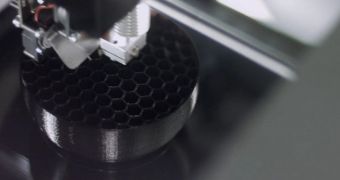Build size, or build ratio, is one of the key specifications of a 3D printer, the part that ultimately determines if you can build something integrally or if you have to settle for making several parts when working on something bigger than your fist.
British company Kora claims to have invented the 3D printer with the largest build ratio in the industry: 230 x 230 x 250 mm / 9.05 x 9.05 x 9.84 inches.
“Normal” FDM 3D printers (Fused Deposition Modeling, where plastic filament is melted and laid into place by an extruder) often don't go above 150 x 150 x 130 mm / 5.90 x 5.90 x 5.11 inches. Indeed, some stick to half of that or less.
The new printer from Kora is called Alpha 3D, or simply Alpha, symbolizing its alleged status as the first among 3D printers. The build volume is of 807 cubic inches / 13,224,360 cubic millimeters.
The print speed is of 30 to 300 mm per second / 1.18 to 11.81 inches, while the travel speed is of 30 mm to 350 mm / 1.18 to 13.77 inches, all done by a fast-heating nozzle and filament with a diameter of 1.75 mm.
As for the resolution, it can go from 400 microns (low detail) to 20 microns (high detail). Clearly, Kora is playing for keeps, something increasingly essential on the consumer market.
You see, 3D printers may be officially considered a type of industrial robot, but FDM models like this one have been shipping to the homes of regular people increasingly often.
The price of $1,895 / €1,395 will put most people off, sure enough, but the folk with no money concerns, as well as those who own a 3D printing shop or service, are bound to jump right on it. Speaking of which, the product should already be selling in red, black, or silver frame colors (solid, powder coated steel).
Besides the large build volume, the Alpha possesses a few other unusual assets, like the fast heating hotplate system, fully integrated LED illumination, an LCD screen, an onboard webcam, an SD card reader, and even Wi-Fi support.
Finally, there is a dual extruder upgrade kit that you can buy for a premium. When attached to the unique VariBLOCK head unit (instead of the normal extruder head), it allows the printer to print from pens, foods, liquids, and other things. All the while, costs are kept down (making a print cost 4 pence per CC of filament extruded, according to the company).

 14 DAY TRIAL //
14 DAY TRIAL //